Located in the Chiang Mai province of northern Thailand, ComPeung offers residencies from two weeks to three months on spectacular grounds comprising 2.8 acres of fishing lakes, forests, and mountains as part of what the website calls the country’s “first non-government artist-in-residence program.” There are two artist houses, which can accommodate up to three at a time (if a couple wants to occupy one of the houses), along with a main “earthen house” with a shared kitchen. One artist house has a basic bedroom, private bathroom, and indoor and outdoor studio spaces; the other has a “maisonette bedroom,” one small bedroom downstairs, a private bath, and indoor and outdoor working spaces. Jodi Colella, who was in residence in the fall of 2016, says the accommodations are “no frills,” but describes the food as “amazing,” both the communal meals at the residency and the street food in a nearby village, which boasts a 700-year-old market.
Colella had previously done a residency in China, where she was forced to use only what she could get her hands on; she hoped for a similar self-sufficiency in Thailand…and got it. Along with some unexpected inspiration. “You’re out in nature and there are a lot of ways for critters to get in and out,” she says. These included tiny frogs and a scorpion that suggested the basis for her first “Stinger” sculptures, recently on view at the Boston Sculptors Gallery. She found fabrics, like stretchy black lace, along with wire, at the local market and hardware store. (ComPeung also has good mobile and internet connections.)
“The people are wonderful,” she says, adding that strangers came to her aid when she fell off her scooter and got on the wrong bus. Though she says the government is a little shaky right now, and there are rebel groups in the far south, Colella never felt in danger. Climate is a factor to keep in mind whenever you do a residency. “It was very hot and humid when I arrived in October, and at first it was oppressive. During certain parts of the day you just have to slow down,” she says. “I came at the end of the rainy season, when there were powerful forceful rains, and then they stopped. It’s considered winter in Thailand, but for us it was like September.”
Cost for a month at ComPeung is about 660 euros, which at the moment translates into $820. Airfare is often less than flying to Europe. “One advantage to going to faraway places is that they often have economies where the dollar is strong,” says Colella. But nonetheless when you’re so remote from your home base, it’s always good to have a back-up plan in case things aren’t working out. “In China, I knew someone, and I knew I was in a safe place,” she says. “For Thailand, I contacted people who had done residencies there in the past, and I discovered it would have been affordable to find another place to stay.”
After she returned from a residency in Shanghai a couple of years back, Elisabeth Condon said she wanted to “find amazing landscapes with spiritual power in North America.” She found one in the tiny town of Carrizozo (pop. 900), in the high desert plains of New Mexico, surrounded by mountains on three sides and a volcanic field to the west. The Carrizozo Artist-in-Residence program is fairly new, founded originally as MoMAZoZo, a community organization designed to “promote the artistic exchange of ideas in an interactive fashion that brings excitement and aesthetic nourishment to Carrizozo,” according to the website.
Paula Wilson, a painter from Brooklyn, and Mike Lagg, a woodworker, teamed up about three years ago with Joan and Warren Malkerson, who live part time in Minnesota, to make Carrizozo and budding arts center. “We have separate living spaces for the artists,” explains Wilson, “a casita in town and a three-bedroom apartment. There are two studios on the ground floor of historic 12th Street, each about 600 to 700 square feet, and there’s one additional studio in the apartment.” Condon says, of the living accommodations, “you get the feeling that someone really cared about them. There’s a full kitchen table, comfortable furniture, and beautiful light.” Though there’s no Internet, the local library offers a connection three times weekly.
Residencies range from two weeks to two months, with a month being the norm. “There are no fees,” Wilson adds, “but there’s also no stipend.” The application process is simple. “As artists ourselves, we know how much time it takes to upload images,” she says. “We look at people’s websites, and we ask for a short paragraph to describe what they want to do here.”
“We can welcome two artists at a time, but we’re encouraging people to apply as friends, collaborative teams, families, or as couples. The apartment can house multiple artists who have a connection to one another. But it’s not a good space for strangers to share.”
The kitchens come equipped with basic supplies, and the town offers three restaurants and a coffee shop, as well as a laundromat, four city parks, a community garden, a handful of galleries, and a yoga studio. The closest grocery store is about 25 minutes away, and there are no places to buy art supplies but a “network of friends and fellow artists will help track down any necessities,” says Wilson. Residents are not expected to show work, or donate to the program, though some choose to give artists’ talks or open up their studios.
“It’s amazing how supportive the community has been,” Wilson adds. “We get a good turnout for any events associated with the artists.”
There are abundant opportunities for hiking and day trips to places like the White Sands National Monument, Three Rivers Petroglyphs, the Valley of Fire, and the hot springs in Truth or Consequences. And the surrounding landscape is truly wild and spectacular. “There’s a kind of sunset in delicate pastel colors that portends a sky filled with stars,” says Condon, who liked to work at night in Carrizozo because of the profound stillness. “You resonate with the ancient and powerful landscape. I couldn’t believe how peaceful it was.”
Because her work is intimately connected to a sense of place, Marietta Patricia Leis has done many residencies that serve to inform her deeply saturated monochromatic paintings. “As I travel I see how the colors of an environment impact people, their worldview and entire cultures,” she writes on her website. She chose to do a month-long residency at the Ionian Center for the Arts and Culture on the Greek island of Kefalonia, in the city of Metaxata, because it’s close to the sea and a good place to absorb the intense Mediterranean hues surrounding the complex.
“No expense has been spared in the building” of this haven, she says, but the website is confusing to navigate, and requests for an interview with the directors went unanswered. “The residency program is open, international, running all year, supporting/advancing high-level artistic and scientific research and creation projects,” says the Ionian Center’s site. “It is inviting artists and scientists, curators…and universities and arts institutions from around the world.” Photos of the grounds and accommodations show light-filled spaces, congenial dining areas, an auditorium, and ample studios. There are rooms and apartments for up to five people, fully equipped with kitchens and bathrooms. “They do charge a fee for housing, which is negotiable,” says Leis. “Meals are supplied or not as agreed, but a make-your-own breakfast was always available with food provided.” Nearby hotels offer swimming pools and tennis courts.
Prices for accommodations vary, with a daily rate at 47 to 75 euros ($58 to $75), including breakfast. The monthly fee, according to the site, is 2150 euros ($2650), but Leis says she paid around $600 for an apartment (two rooms, two baths, and a kitchen), perhaps because the Greece economy was in freefall when she visited.
“There were opportunities to be shown the sights and visit residents’ homes by friends of the center,” says Leis, who was with her husband and rented a car to tool about the island on their own. “It’s a very pleasant place to hang out, very congenial to guests, and with few Americans in residence.” She adds that there are direct flights from London to Athens.
Best advice: contact the center directly for specifics: info@ionianartscenter@gmail.com
The Sam and Adele Golden Foundation for the Arts is a not-for-profit organization, offering artist residencies in a handsomely refurbished cow barn in upstate New York. The only requirement for those considering this residency is that “they must work with paint,” says Barbara Golden, director of the foundation. Not surprising, given that Golden Artist Colors is a leading manufacturer of artist paints.
The Golden Foundation was spawned in 1997 in honor of art patrons Sam and Adele Golden, and as a way to give back to artists. The studio barn is right down the road from Golden Artist Colors, and opportunities abound for resident artists to work in the labs with “material application specialists” in two-hour “technicals,” covering everything from grounds and substrate preparation, to paint surfaces in acrylics, oils and watercolor, to top coats and varnishes. Other examples of technicals include “Frugal Use of Water, “Crash Your Solids” (environmentally friendly ways to reduce studio waste water), “To Varnish or Not to Varnish,” “Mark Making,” and “Pack and Ship Your Artwork.” The rest of a resident’s day is typically spent in the studio, putting to the test information gained in the technicals, and playing and experimenting with unlimited amounts paints and mediums provided by the factory. Artists can also request custom-produced materials.
“Or you can just hole up in your studio and paint,” says artist Phillip Garrett, who was in residence in November 2016. “For me, this was about getting out of my studio, away from my routines, and interacting with people I really respect.” The surrounding landscape, he adds, is spectacular, and provided much inspiration for his paintings on paper and canvas. (The residency sits on over 140 acres of rolling countryside, with a range of walking trails.).
Four-week residencies run from late February through mid-November, with three artists living and working in private apartments and studios, and sharing a communal studio space in the barn. “The whole downstairs is an open kitchen, dining room, and living area,” says Emma Golden, director of the program, who adds that her father, Mark, occasionally pitches in to cook meals for the group. Artists can pick up groceries en route, or make trips to a market 30 minutes away. The nearest town is New Berlin, a five-minute drive from the residency, which is a four-hour drive north of New York City (artists can also arrive by train in Utica, or plane in Syracuse).
For a time, Golden had a sliding pay scale for the individual residencies, based on artists’ incomes. But since 2017, there is no fee for the four weeks, and in the future the foundation hopes to offer stipends to those in need. Artists are responsible for groceries and travel to and from the residency. The website advises that residents “should plan to bring their own tools, canvas, and paper. Some canvas and paper will be available through the Golden Foundation,” but all paint materials are provided by the company.
“There is a celebration of open studios at the end of each residency session, when the doors are opened to our art-loving community, who delight in meeting the artists and viewing their experiments and work,” says Barbara Golden. In the year following residency, an annual art exhibition, “Made in Paint,” is hosted by the Foundation at the Sam and Adele Golden Gallery, with artwork from the prior year’s residents. For more information, visit:
Ann Landi
Top: Marietta Patricia Leis in her studio at the Ionian Center for Arts and Culture on the island of Kefalonia, Greece

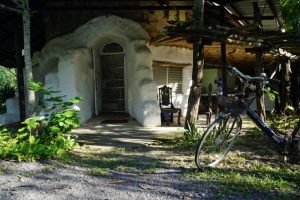
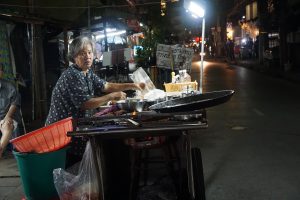
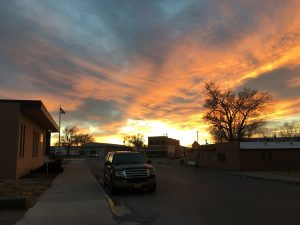
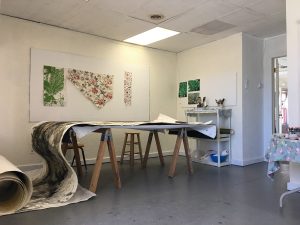
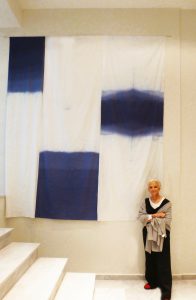
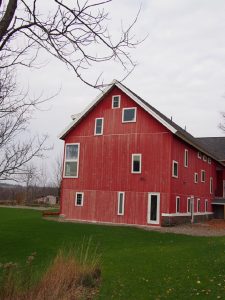
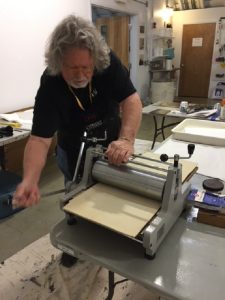
Thank you Ann, you are my sunshine!
I always look forward to your news.
xo Hester
I love this feature. It satisfies my wanderlust and fantasies about extended alone time. Someday I will apply to residencies!